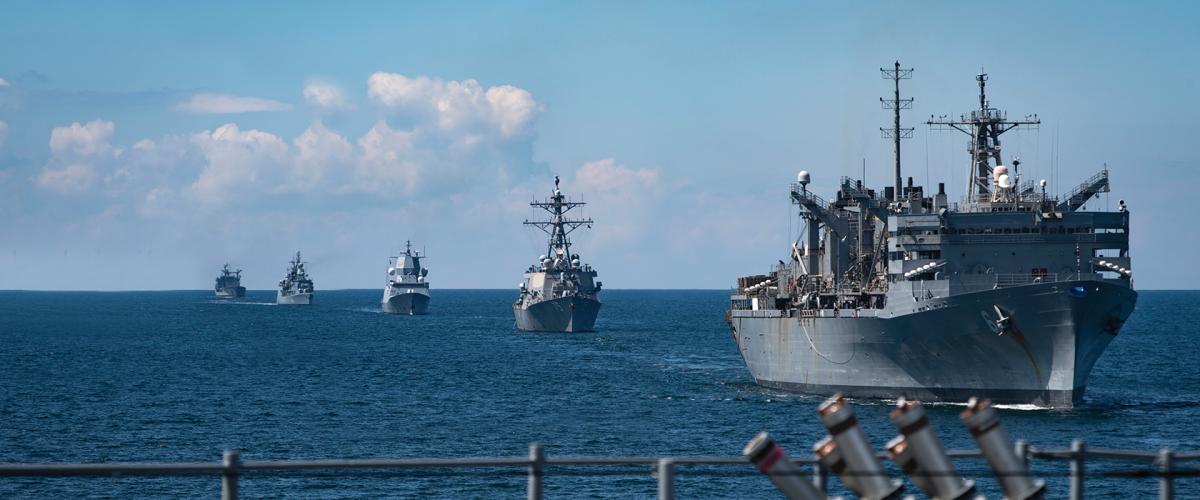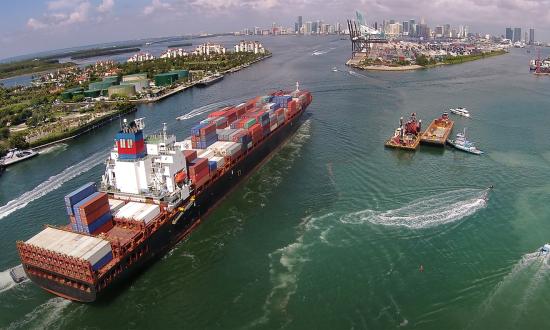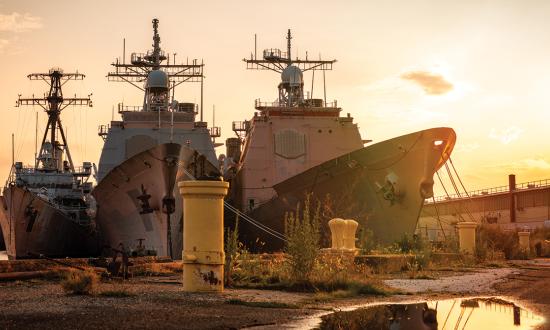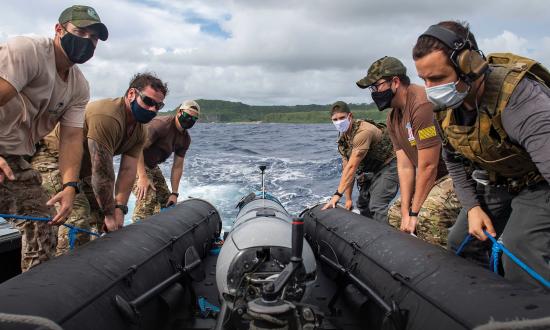In December 2020, the Navy, Marine Corps, and Coast Guard released Advantage at Sea, the second joint Sea Services strategy in U.S. history and the first such document since 2015’s Cooperative Strategy for 21st Century Sea Power.1Advantage at Sea reflects the strategic shift to great power competition articulated in the 2018 National Defense Strategy (NDS). It aligns the Sea Service strategy with the NDS direction to pursue “urgent change at significant scale.”2 In doing so, it prioritizes how the services will restructure and align capital investment to prepare for possible conflict with China or Russia. It also provides clear examples of how force employment will change at the operational level to better accomplish the new strategic goals. This is a significant step forward, but what remains is the hard work of linking the ideas in strategy to well-resourced and coordinated operations that achieve strategic effects.
Habits are a product of learned reinforced lessons, and often are useful, helping regulate behavior, improve efficiency, and organize more quickly; but even good habits can create bias that minimizes novel, negative feedback. Two decades of focus on countering violent extremist organizations and the U.S. status as the lone global superpower likely have shaped structures, processes, and habits in ways that are no longer relevant.
The Navy must ensure the processes and habits that transform resources and strategy into actions remain effective as it shifts strategies.
Global Force Management
The NDS has accelerated military planning and restructuring toward great power competition over the past three years. Advantage at Sea includes direct references to many of the naval force structure and employment concepts that have since gained traction. For example, it highlights increased investment in platforms to overcome adversary antiaccess/area-denial capabilities, development and implementation of expeditionary advanced base operations (EABO), distributed maritime operations, and development of platforms and tactics to execute littoral operations in a contested environment.3 It also emphasizes competition below the level of armed conflict.4 These concepts and emphases can help the services shift the way they envision operations and guide how they will establish a credible deterrent force at sea. They do not, however, address some of the more quotidian processes that can affect operations, such as the Global Force Management (GFM) process.
Multilateral mine countermeasures experiments in the Baltic Sea would better prepare the fleet for future great power competition with Russia. Here, sailors lower a MK 18 Mod 2 unmanned undersea vehicle during a BALTOPs mine countermeasures exercise. U.S. Navy (Shannon Renfroe)
The NDS focus should compel dramatic changes to naval force disposition around the globe and even to the GFM system itself.5 The Department of Defense (DoD) did institute one significant change to the GFM process—dynamic force employment—to confront adversaries with greater operational uncertainty. This provides additional flexibility to move forces among theaters more quickly, to drive or respond to events in the short term. However, it is hard to find clear examples of how the NDS has translated into significant changes in the assignment or allocation of forces.
In contrast to the adoption of dynamic force employment, the Navy has made less progress adjusting force assignment or allocation through the GFM process to address new strategic priorities, particularly in the European theater. Several factors may slow responsiveness of the GFM process to changes in strategy. For example, at the strategic level, effects often take years to be realized, and progress is not always linear. Forces also may be engaged in missions that are multiyear commitments. In addition, shifts in forces may require new diplomatic agreements or send politically uncomfortable signals to regions from which forces would depart. In the present, interconnected world, a commander also may argue that forces and actions in his or her respective theater have valuable strategic effects on an adversary a world away (e.g., Chinese investment and activities across Africa have made it a relevant, though remote, setting for competition).
Resourcing Operational Forces
The GFM process validates demand for capabilities and is intended to distribute those capabilities according to strategic priorities. Greater combatant command demand for a capability is expected to stimulate the respective service’s attention to that capability (i.e., the forces and platforms that conduct the required missions and the service’s capacity to provide those forces). When forces are retained on lower-priority missions through inertia, rather than shifting to strategic priorities, it undermines strategic efforts and even risks reducing the perceived value of misaligned units.
At the service level, a major shift in strategy without significant changes in force disposition compels the question: What forces are misaligned and at risk of “dying on the vine” from inefficient use? To the extent that these inefficiencies come from a habit of historical employment, the services must overcome inertia as they adjust to a new strategy.
In addition, there has been little effort to revise major operational command-and-control organizations across the Sea Services to adjust to great power competition priorities. In the wake of the Cold War and the shift to a strategy focused on countering violent extremist organizations in the Central Command area of responsibility, Naval Forces Europe and the Sixth Fleet consolidated to their present shared headquarters and staff structure in Naples. That shift, executed in 2005, reflected changing strategic priorities and the reduced relative strategic importance of operations in the European theater.
The creation of Africa Command in 2008, and its associated Naval Forces Africa and Commander, Task Force Six, organizations, resulted in administrative divisions but brought no real additional staff resources to the now quadruple-hatted command-and-control staff in Naples. This organization, which shares its commanders with NATO’s Joint Force Command Naples and Naval Striking and Support Forces, NATO, provides an unbalanced comparison with the Navy component’s robust command-and-control organization in the Pacific, which includes a unique service component headquarters supported by two separate numbered fleets. No one should expect the Navy component serving the European and African areas of responsibility to rival the size of the Indo-Pacific organization, but a renewed focus on great power competition and dealing with Russian malign influence and activity in the European theater should prompt a reevaluation of command-and-control capacity and structure in the region.
There are ongoing discussions about consolidation of the Naval Forces Europe–Naval Forces Africa structure with Marine Forces Africa and Europe, but consolidation is an effort to seek efficiencies in a larger organization. It indicates that headquarters resourcing improvements may not accompany the heightened strategic priority placed on the European theater. Also, since the consolidation would bring expanded responsibility, it is not clear how much efficiency would be gained. The Navy appears, in this case, to have fallen into the habit of assuming that the current system’s lack of failure indicates adequate resourcing. This is not yet a crisis, but it is an aspect of an existing operational structure that deserves consideration as the Sea Services adapt.
Shifting Mission Priorities
Habits of thought and biases that shape how the Sea Services view mission priorities also deserve scrutiny. After nearly two decades of consistent, high-operational-tempo security and stability operations in the Middle East, Central Asia, and Africa, career professionals might be forgiven for assuming that their experience accurately encompasses the “what and how” of military operations to achieve national objectives from the sea. However, the tactics, operations, and areas that have been the focus of recent military activity do not reflect emerging strategic defense priorities. That shift in perspective is complicated by legacy U.S. commitments in those regions. The habit of thinking that last year’s top priority remains a top priority is born from experience. Fleet leaders wrestle with the tendency to support these diminishing, legacy priorities as they evaluate how to use existing capabilities to compete using new tactics in different operating environments against Russian or Chinese activities.
The NDS identifies Russia and China as key strategic adversaries and categorizes both as revanchist powers. They seek to subvert the existing global, rules-based order and undermine U.S. global power and influence by attacking the political institutions and alliances on which that power is based. Recognizing that both nations pose a sophisticated, strategic threat to U.S. power, the NDS offered a new strategic lens through which to assess how best to use military power to counteract their strategies.
The terms “contact layer” and “blunt layer,” and the concept of forces associated with those layers, are introduced in the NDS to characterize what strategic functions a force provides. A distinguishing element of these terms is that they are agnostic regarding the warfare or mission area of the force(s) in question—only the strategic purpose matters.6 This approach clarifies the strategic activity in which the force should be engaged and helps to assess corresponding priority, regardless of warfare or mission type. For combatant commanders outside the United States, nearly all operational naval forces are blunt-layer forces (deterrence), and most spend significant time engaged as contact-layer forces as well.
The NDS summarizes contact-layer forces as “designed to help us compete more effectively below the level of armed conflict.” This definition does not change how forces are employed in operations throughout the fleet. Forces still establish maritime domain awareness, conduct freedom of navigation operations (FONOPs), participate in exercises, execute ballistic-missile-defense patrols, and more. When viewed through the new strategic lens, however, the relative value of those missions to national defense might change. This perspective should help leaders and their staffs overcome ingrained habits or experience-based biases for some missions over others. As strategic effects are evaluated through a new lens, in a context that prioritizes competition activities among great powers, different missions may be prioritized.
For example, ballistic-missile-defense patrols would appear to be the most important mission on the preceding list. This is a complicated mission, and the consequences of failure are serious. Certainly, in past years, providing elements of integrated air- and missile-defense would be considered more valuable than most other missions. The context of prior conflicts clearly prioritized such missions. Today, from a strategic perspective, perhaps FONOPs in the South China Sea or a multilateral exercise that includes experimenting with mine countermeasures and EABO in the Baltic Sea have greater strategic value. These activities present significant value in that they support the international legal structure or strategic alliances on which U.S. power is based. The NDS provides a helpful framework for such assessments, and there would be value in further Sea Service–level guidance on priorities.7
This does not imply that these activities represent binary choices or trade-offs. Rather, as the Navy works at the fleet level to allocate time and resources to missions, the rules for the strategic calculus today should look different from five years ago. For example, if an exercise plays a role in competition or establishing great power deterrence (e.g., distributed maritime operations or expeditionary advanced base operations), it should be resourced in accordance with its strategic importance.
Unfortunately, this is not how funding is organized at the combatant- or component-command levels. Funding for exercises and operations exists in a variety of accounts with limited flexibility. In fact, funding for exercises in the European theater has fallen in recent years, with a nearly 20 percent drop in Navy exercise funding anticipated in fiscal year 2021. The discord of strategic emphasis on activity in the contact layer while funding for relevant contact-layer activities such as interoperability exercises with key allies decreases does not escape those tasked with their planning and management. This discord encourages the habits of thought and preference for activities that historically attract funding. The effect is that the Sea Services are less likely to pursue or execute the full range of available contact-layer activities across the theater, missing opportunities to develop an understanding of the operating environment, build interoperability, and develop and display new tactics and capabilities.
Major shifts in strategy are uncommon, occurring perhaps once every few decades. They drive changes in procurement and force structure, and they focus attention on new ways to employ forces. Advantage at Sea rightly devotes significant energy to these issues. Processes and biases within the Sea Services’ cultures are not the focus or the means of strategy, but they constitute important elements of the environment in which the strategy is executed. Particularly as the Sea Services shift to a new strategy, they must understand how existing processes and structures influence translation of that strategy into effective operations. The GFM process—and biases within its execution—affects U.S. maritime presence around the globe. Major operational command-and-control structures affect the capacity for effective force employment. Resourcing to forward-deployed forces should reflect the strategic importance of their activities.
The NDS asked for a “transformation of how the DoD conducts business.”8 The Sea Services must take this opportunity to evaluate whether the structures, processes, and biases that served them well in the past remain fit for purpose.
1. Department of the Navy, Advantage at Sea: Prevailing with Integrated All-Domain Naval Power (Washington, DC: Office of the Secretary of the Navy, 2020), 1.
2. Department of Defense, National Defense Strategy (Washington, DC: Department of Defense, 2018), 37.
3. Department of the Navy, Advantage at Sea, 13.
4. Department of the Navy, 6.
5. The Global Force Management process is the Department of Defense system for managing the assignment, allocation, and apportionment of military forces globally to operation commanders. A detailed discussion of assignment, allocation, and apportionment can be found in Joint Chiefs of Staff, Joint Publication 3-35: Deployment and Redeployment Operations (Washington, DC: Joint Chiefs of Staff, 2018), I-4 and I-5.
6. Contact, blunt, surge, and homeland defense layers are part of the Global Operating Model (GOM) articulated in the NDS. See the unclassified summary in the Summary of the 2018 National Defense Strategy (Washington, DC: Office of the Secretary of Defense, 2018), 7.
7. Department of Defense, National Defense Strategy, 22–23. Primary and support “competition missions” are unclassified, but overall document classification is Secret. The “Day-to-Day Competition Framework, Table 2” can be found on p. 26.
8. Department of Defense, National Defense Strategy, 1.








